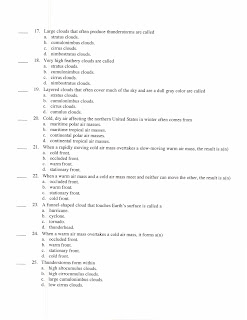

Print these sheets out and use to make up the lab on Tornado Movement.
Students will be able to:
use information from hands-on activities, videos from the internet and classroom discussion to
-identify the role of models in the context of the sixth grade science benchmarks.
-discuss, compare, and negotiate methods used, results obtained, and explanations among
groups of students conducting the same investigation.
-investigate how natural disasters have affected human life in Florida.
Students first watched a portion of a video from Storm Chasers about tornadoes. They answered questions such as what is the difference between a tornado and a hurricane? How does a tornado form?
Students received their lab sheets. They made models of tornados in a bottle and used them to show how tornados form and move.
Absent students should go to the following site and paste the URL address into the URL box. Then, manipulate the width and core pressure to guess the type of tornado produced. Be sure to record data. You can use the individual investigation sheets to write up the lab. (See top of blog)
http://whyfiles.org/013tornado/3.html
On Friday (no class on Thursday, due to early release), students debriefed the mini-assessment in science. They then completed the laboratory write-up. Students also finished gathering the weather data.




























